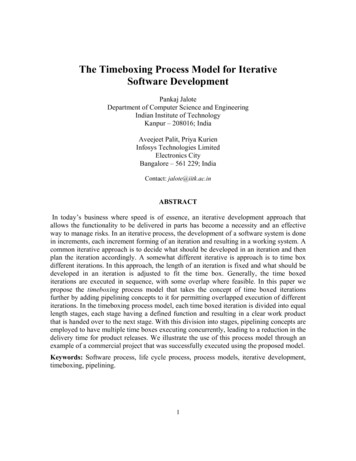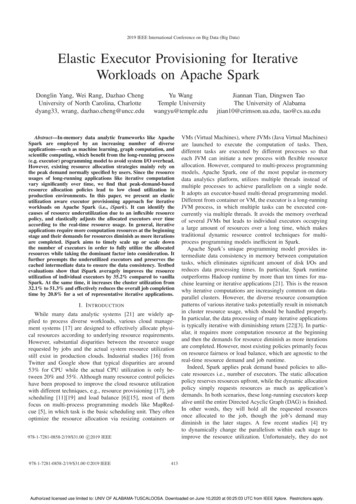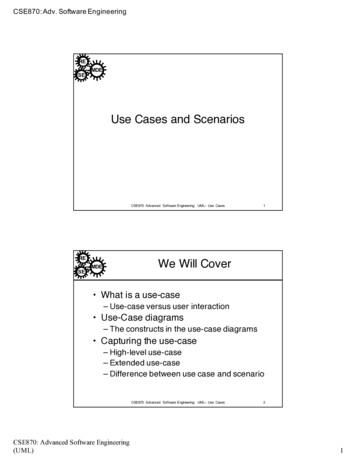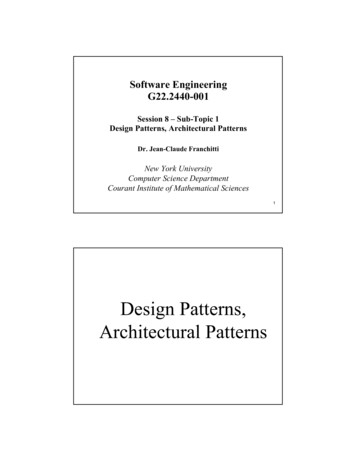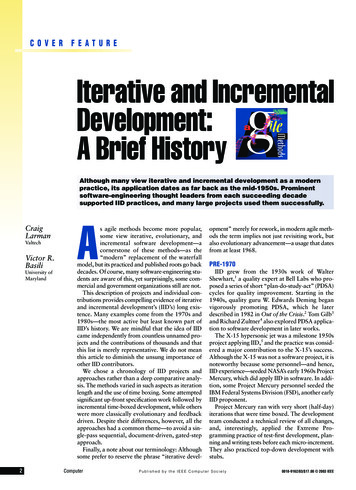
Transcription
COVER FEATUREIterative and IncrementalDevelopment:A Brief HistoryAlthough many view iterative and incremental development as a modernpractice, its application dates as far back as the mid-1950s. Prominentsoftware-engineering thought leaders from each succeeding decadesupported IID practices, and many large projects used them successfully.CraigLarmanValtechVictor R.BasiliUniversity ofMaryland2As agile methods become more popular,some view iterative, evolutionary, andincremental software development—acornerstone of these methods—as the“modern” replacement of the waterfallmodel, but its practiced and published roots go backdecades. Of course, many software-engineering students are aware of this, yet surprisingly, some commercial and government organizations still are not.This description of projects and individual contributions provides compelling evidence of iterativeand incremental development’s (IID’s) long existence. Many examples come from the 1970s and1980s—the most active but least known part ofIID’s history. We are mindful that the idea of IIDcame independently from countless unnamed projects and the contributions of thousands and thatthis list is merely representative. We do not meanthis article to diminish the unsung importance ofother IID contributors.We chose a chronology of IID projects andapproaches rather than a deep comparative analysis. The methods varied in such aspects as iterationlength and the use of time boxing. Some attemptedsignificant up-front specification work followed byincremental time-boxed development, while otherswere more classically evolutionary and feedbackdriven. Despite their differences, however, all theapproaches had a common theme—to avoid a single-pass sequential, document-driven, gated-stepapproach.Finally, a note about our terminology: Althoughsome prefer to reserve the phrase “iterative devel-Computeropment” merely for rework, in modern agile methods the term implies not just revisiting work, butalso evolutionary advancement—a usage that datesfrom at least 1968.PRE-1970IID grew from the 1930s work of WalterShewhart,1 a quality expert at Bell Labs who proposed a series of short “plan-do-study-act” (PDSA)cycles for quality improvement. Starting in the1940s, quality guru W. Edwards Deming beganvigorously promoting PDSA, which he laterdescribed in 1982 in Out of the Crisis.2 Tom Gilb3and Richard Zultner4 also explored PDSA application to software development in later works.The X-15 hypersonic jet was a milestone 1950sproject applying IID,5 and the practice was considered a major contribution to the X-15’s success.Although the X-15 was not a software project, it isnoteworthy because some personnel—and hence,IID experience—seeded NASA’s early 1960s ProjectMercury, which did apply IID in software. In addition, some Project Mercury personnel seeded theIBM Federal Systems Division (FSD), another earlyIID proponent.Project Mercury ran with very short (half-day)iterations that were time boxed. The developmentteam conducted a technical review of all changes,and, interestingly, applied the Extreme Programming practice of test-first development, planning and writing tests before each micro-increment.They also practiced top-down development withstubs.Published by the IEEE Computer Society0018-9162/03/ 17.00 2003 IEEE
The recollections of Gerald M. Weinberg, whoworked on the project, provide a window into somepractices during this period. In a personal communication, he wrote:We were doing incremental development as earlyas 1957, in Los Angeles, under the direction ofBernie Dimsdale [at IBM’s Service BureauCorporation]. He was a colleague of John vonNeumann, so perhaps he learned it there, orassumed it as totally natural. I do remember HerbJacobs (primarily, though we all participated)developing a large simulation for Motorola, wherethe technique used was, as far as I can tell, indistinguishable from XP.When much of the same team was reassembledin Washington, DC in 1958 to develop ProjectMercury, we had our own machine and the newShare Operating System, whose symbolic modification and assembly allowed us to build the systemincrementally, which we did, with great success.Project Mercury was the seed bed out of whichgrew the IBM Federal Systems Division. Thus, thatdivision started with a history and tradition ofincremental development.All of us, as far as I can remember, thoughtwaterfalling of a huge project was rather stupid,or at least ignorant of the realities I think whatthe waterfall description did for us was makeus realize that we were doing something else,something unnamed except for “software development.”The earliest reference we found that specificallyfocused on describing and recommending iterativedevelopment was a 1968 report from Brian Randelland F.W. Zurcher at the IBM T.J. Watson ResearchCenter.6 M.M. Lehman later described Randell andZurcher’s work and again promoted iterative development in his September 1969 internal report toIBM management on development recommendations:7The basic approach recognizes the futility of separating design, evaluation, and documentationprocesses in software-system design. The designprocess is structured by an expanding modelseeded by a formal definition of the system, whichprovides a first, executable, functional model. It istested and further expanded through a sequenceof models, that develop an increasing amount offunction and an increasing amount of detail as tohow that function is to be executed. Ultimately,the model becomes the system.Another 1960s reference comes fromRobert Glass:8It is the opinion of the author that incremental development is worthwhile, [it] leads toa more thorough system shakedown, avoidsimplementer and management discouragement.THE SEVENTIES“We were doingincrementaldevelopment asearly as 1957, inLos Angeles, underthe direction ofBernie Dimsdale[at IBM’sService BureauCorporation].”In his well-known 1970 article, “Managing the Development of Large SoftwareSystems,” Winston Royce shared his opinions on what would become known as thewaterfall model, expressed within the constraints of government contracting at thattime.9 Many—incorrectly—view Royce’s paper asthe paragon of single-pass waterfall. In reality, herecommended an approach somewhat differentthan what has devolved into today’s waterfall concept, with its strict sequence of requirements analysis, design, and development phases. Indeed,Royce’s recommendation was to do it twice:If the computer program in question is beingdeveloped for the first time, arrange matters sothat the version finally delivered to the customerfor operational deployment is actually the secondversion insofar as critical design/operations areasare concerned.Royce further suggested that a 30-month projectmight have a 10-month pilot model and justifiedits necessity when the project contains novel elements and unknown factors (hardly a unique case).Thus, we see hints of iterative development, feedback, and adaptation in Royce’s article. This iterative feedback-based step has been lost in mostdescriptions of this model, although it is clearly notclassic IID.What did Royce think about the waterfall versus IID when he learned of the latter approach? Ina personal communication, Walker Royce, his sonand a contributor to popular IID methods in the1990s, said this of his father and the paper:He was always a proponent of iterative, incremental, evolutionary development. His paperdescribed the waterfall as the simplest description,but that it would not work for all but the moststraightforward projects. The rest of his paperdescribes [iterative practices] within the contextof the 60s/70s government-contracting models (aserious set of constraints).June 20033
The first majordocumentedIBM FSD IIDapplication wasthe life-criticalcommand andcontrol system forthe first US Tridentsubmarine.This was an ironic insight, given the influence this paper had as part of the bulwarkpromoting a strict sequential life cycle forlarge, complex projects.The next earliest reference comes fromHarlan Mills, a 1970s software-engineeringthought leader who worked at the IBM FSD.In his well-known “Top-Down Programmingin Large Systems,” Mills promoted iterativedevelopment. In addition to his advice tobegin developing from top-level control structures downward, perhaps less appreciatedwas the related life-cycle advice Mills gave forbuilding the system via iterated expansions:10 it is possible to generate a sequence of intermediate systems of code and functional subspecifications so that at every step, each [intermediate]system can be verified to be correct Clearly, Mills suggested iterative refinement forthe development phase, but he did not mentionavoiding a large up-front specification step, did notspecify iteration length, and did not emphasizefeedback and adaptation-driven development fromeach iteration. He did, however, raise these pointslater in the decade. Given his employment at theIBM FSD, we suspect Mills’s exposure to the moreclassic IID projects run there in the early 1970sinfluenced his thought, but we could not confirmthis with colleagues.Early practice of more modern IID (feedback-driven refinement with customer involvement andclearly delineated iterations) came under the leadership of Mike Dyer, Bob McHenry, and DonO’Neill and many others during their tenure at IBMFSD. The division’s story is fascinating because ofthe extent and success of its IID use on large, lifecritical US Department of Defense (DoD) space andavionics systems during this time.The first major documented IBM FSD application of IID that we know of was in 1972. This wasno toy application, but a high-visibility life-criticalsystem of more than 1 million lines of code—thecommand and control system for the first USTrident submarine. O’Neill was project manager,and the project included Dyer and McHenry.O’Neill conceived and planned the use of IID(which FSD later called “integration engineering”)on this project; it was a key success factor, and hewas awarded an IBM Outstanding ContributionAward for the work. (Note that IBM leadership visibly approved of IID methods.)The system had to be delivered by a certain date4Computeror FSD would face a 100,000 per day late penalty.The team organized the project into four timeboxed iterations of about six months each. Therewas still a significant up-front specification effort,and the iteration was longer than normally recommended today. Although some feedback-driven evolution occurred in the requirements, O’Neill notedthat the IID approach was also a way to manage thecomplexity and risks of large-scale development.11Also in 1972, an IBM FSD competitor, TRW,applied IID in a major project—the 100 millionTRW/Army Site Defense software project for ballistic missile defense. The project began in February1972, and the TRW team developed the system infive iterations. Iteration 1 tracked a single object,and by iteration 5, a few years later, the system wascomplete. The iterations were not strictly timeboxed, and there was significant up-front specification work, but the team refined each iteration inresponse to the preceding iteration’s feedback.12As with IBM FSD, TRW (where Royce worked)was an early adopter of IID practices. Indeed, BarryBoehm, the originator of the IID spiral model in themid-1980s, was chief scientist at TRW.Another mid-1970s extremely large applicationof IID at FSD was the development of the LightAirborne Multipurpose System, part of the USNavy’s helicopter-to-ship weapon system. A fouryear 200-person-year effort involving millions oflines of code, LAMPS was incrementally deliveredin 45 time-boxed iterations (one month per iteration). This is the earliest example we found of aproject that used an iteration length in the range ofone to six weeks, the length that current popularIID methods recommend. The project was quitesuccessful: As Mills wrote, “Every one of thosedeliveries was on time and under budget.”13In 1975, Vic Basili and Joe Turner published apaper about iterative enhancement that clearlydescribed classic IID:14The basic idea behind iterative enhancement is todevelop a software system incrementally, allowingthe developer to take advantage of what was beinglearned during the development of earlier, incremental, deliverable versions of the system.Learning comes from both the development anduse of the system, where possible. Key steps in theprocess were to start with a simple implementation of a subset of the software requirements anditeratively enhance the evolving sequence of versions until the full system is implemented. At eachiteration, design modifications are made alongwith adding new functional capabilities.
The paper detailed successful IID application tothe development of extendable compilers for a family of application-specific programming languageson a variety of hardware architectures. The projectteam developed the base system in 17 iterationsover 20 months. They analyzed each iteration fromboth the user’s and developer’s points of view andused the feedback to modify both the languagerequirements and design changes in future iterations. Finally, they tracked measures, such as coupling and cohesion, over the multiple iterations.In 1976, Tom Gilb published Software Metrics(coining the term), in which he discussed his IIDpractice—evolutionary project management—andintroduced the terms “evolution” and “evolutionary” to the process lexicon. This is the earliest bookwe could find that had a clear IID discussion andpromotion, especially of evolutionary delivery:3“Evolution” is a technique for producing theappearance of stability. A complex system will bemost successful if it is implemented in small stepsand if each step has a clear measure of successfulachievement as well as a “retreat” possibility to aprevious successful step upon failure. You have theopportunity of receiving some feedback from thereal world before throwing in all resourcesintended for a system, and you can correct possible design errors The book marked the arrival of a long-standingand passionate voice for evolutionary and iterativedevelopment. Gilb is one of the earliest and mostactive IID practitioners and promoters. He beganthe practice in the early 1960s and went on toestablish several IID milestones. His material wasprobably the first with a clear flavor of agile, light,and adaptive iteration with quick results, similarto that of newer IID methods.By 1976, Mills had strengthened his IID message:15Software development should be done incrementally, in stages with continuous user participationand replanning and with design-to-cost programming within each stage.Using a three-year inventory system project as abackdrop, he challenged the idea and value of upfront requirements or design specification:.there are dangers, too, particularly in the conduct of these [waterfall] stages in sequence, andnot in iteration-i.e., that development is done inan open loop, rather than a closed loop withuser feedback between iterations. The dangerin the sequence [waterfall approach] is that theproject moves from being grand to beinggrandiose, and exceeds our human intellectualcapabilities for management and control.Tom Gilbintroduced theterms “evolution”and “evolutionary”to the processlexicon.And perhaps reflecting several years of seeing IID in action at FSD, Mills asked, “.whydo enterprises tolerate the frustrations anddifficulties of such [waterfall] development?”In 1977, FSD incorporated the Trident IIDapproach, which included integrating all softwarecomponents at the end of each iteration into itssoftware-engineering practices—an approachMcHenry dubbed “integration engineering.” SomeTrident team members and Mills were key advisersin this incorporation effort.16 Integration engineering spread to the 2,500 FSD software engineers, and the idea of IID as an alternative to thewaterfall stimulated substantial interest withinIBM’s commercial divisions and senior customerranks and among its competitors.Although unknown to most software professionals, another early and striking example of amajor IID success is the very heart of NASA’s spaceshuttle software—the primary avionics softwaresystem, which FSD built from 1977 to 1980. Theteam applied IID in a series of 17 iterations over 31months, averaging around eight weeks per iteration.17 Their motivation for avoiding the waterfalllife cycle was that the shuttle program’s requirements changed during the software developmentprocess. Ironically (in hindsight), the authors soundalmost apologetic about having to forego the“ideal” waterfall model for an IID approach:Due to the size, complexity, and evolutionary[changing requirements] nature of the program, itwas recognized early that the ideal software development life cycle [the waterfall model] could notbe strictly applied.However, an implementationapproach (based on small incremental releases)was devised for STS-1 which met the objectives byapplying the ideal cycle to small elements of theoverall software package on an iterative basis.The shuttle project also exhibited classic IID practices: time-boxed iterations in the eight-week range,feedback-driven refinement of specifications, andso on.The first IID discussion in the popular press thatwe could find was in 1978, when Tom Gilb beganpublishing a column in the UK’s Computer Weekly.June 20035
The IID practiceof evolutionaryprototyping wascommonly usedin 1980s effortsto create artificialintelligencesystems.The column regularly promoted IID, as wellas evolutionary project management anddelivery. In his 6 April 1978 column, Gilbwrote,Management does not require firm estimatesof completion, time, and money for the entireproject. Each [small iterative] step must meetone of the following criteria (priority order):either (a) give planned return on investmentpayback, or, if impossible, then (b) givebreakeven (no loss); or, at least, (c) some positive user benefit measurably; or, at least (d)some user environment feedback and learning.Another discussion of incremental development,although published in 1984, refers to a SystemDevelopment Corp. project to build an air defensesystem, which began in 1977 and finished in 1980.The project combined significant up-front specifications with incremental development and builds.Ostensibly, the project was meant to fit within DoDsingle-pass waterfall standards, with testing andintegration in the last phase. Carolyn Wong comments on the unrealism of this approach and theteam’s need to use incremental development:18The [waterfall] model was adopted because software development was guided by DoD standards In reality, software development is acomplex, continuous, iterative, and repetitiveprocess. The [waterfall model] does not reflect thiscomplexity.THE EIGHTIESIn 1980 Weinberg wrote about IID in “AdaptiveProgramming: The New Religion,” published inAustralasian Computerworld. Summarizing thearticle, he said, “The fundamental idea was to buildin small increments, with feedback cycles involving the customer for each.” A year later, Tom Gilbwrote in more detail about evolutionary development.19In the same year, Daniel McCracken and MichaelJackson promoted IID and argued against the “stultifying waterfall” in a chapter within a softwareengineering and design text edited by WilliamCotterman. The chapter’s title, “A MinorityDissenting Position,” underscored the subordinateposition of IID to the waterfall model at the time.20Their arguments continued in “Life-Cycle ConceptConsidered Harmful,”21 a 1982 twist on EdsgerDijkstra’s late 1960s classic “Go To StatementConsidered Harmful.”22 (The use of “life cycle” as6Computera synonym for waterfall during this period suggestsits unquestioned dominance. Contrast this to itsqualified use in the 1990s, “sequential life cycle”or “iterative life cycle.”)In 1982, William Swartout and Robert Balzerargued that specification and design have a necessary interplay, and they promoted an iterative andevolutionary approach to requirements engineering and development.23 The same year also provided the earliest reference to a very large application successfully built using evolutionary prototyping, an IID approach that does not usuallyinclude time-boxed iterations. The 100 millionmilitary command and control project was basedon IBM’s Customer Information Control Systemtechnology.24In 1983, Grady Booch published SoftwareEngineering with Ada,25 in which he described aniterative process for growing an object-oriented system. The book was influential primarily in the DoDdevelopment community, but more for the objectoriented design method than for its iterative advice.However, Booch’s later 1990s books that coveredIID found a large general audience, and many firstconsidered or tried iterative development throughtheir influence.The early 1980s was an active period for the(attempted) creation of artificial intelligence systems,expert systems, and so on, especially using Lispmachines. A common approach in this communitywas the IID practice of evolutionary prototyping.26In another mid-1980s questioning of the sequential life cycle, Gilb wrote “Evolutionary Deliveryversus the ‘Waterfall Model.’” In this paper, Gilbpromoted a more aggressive strategy than other IIDdiscussions of the time, recommending frequent(such as every few weeks) delivery of useful resultsto stakeholders.27A 1985 landmark in IID publications wasBarry Boehm’s “A Spiral Model of SoftwareDevelopment and Enhancement,” (although themore frequent citation date is 1986).28 The spiralmodel was arguably not the first case in which ateam prioritized development cycles by risk: Gilband IBM FSD had previously applied or advocatedvariations of this idea, for example. However, thespiral model did formalize and make prominentthe risk-driven-iterations concept and the need touse a discrete step of risk assessment in each iteration.In 1986, Frederick Brooks, a prominent software-engineering thought leader of the 1970s and1980s, published the classic “No Silver Bullet”extolling the advantages of IID:29
Nothing in the past decade has so radicallychanged my own practice, or its effectiveness [asincremental development].Commenting on adopting a waterfall process,Brooks wroteMuch of present-day software acquisition procedure rests upon the assumption that one can specify a satisfactory system in advance, get bids forits construction, have it built, and install it. I thinkthis assumption is fundamentally wrong, and thatmany software acquisition problems spring fromthat fallacy.Perhaps summing up a decade of IID-promotingmessages to military standards bodies and otherorganizations, Brooks made his point very clear inhis keynote speech at the 1995 InternationalConference on Software Engineering: “The waterfall model is wrong!”In 1986, David Parnas and Paul Clements published “A Rational Design Process: How and Whyto Fake It.”30 In it, they stated that, although theybelieve in the ideal of the waterfall model (thorough,correct, and clear specifications before development), it is impractical. They listed many reasons,including (paraphrased) A system’s users seldom know exactly whatthey want and cannot articulate all they know. Even if we could state all requirements, thereare many details that we can only discoveronce we are well into implementation. Even if we knew all these details, as humans,we can master only so much complexity. Even if we could master all this complexity,external forces lead to changes in requirements, some of which may invalidate earlierdecisions.and commented that for all these reasons, “the picture of the software designer deriving his design ina rational, error-free way from a statement ofrequirements is quite unrealistic.”In 1987, TRW launched a four-year project tobuild the Command Center Processing and DisplaySystem Replacement (CCPDS-R), a command andcontrol system, using IID methods. Walker Roycedescribed the effort in 60 pages of detail.31 Theteam time-boxed six iterations, averaging aroundsix months each. The approach was consistentwith what would later become the RationalUnified Process (to which Royce contributed):attention to high risks and the core architecture in the early iterations.Bill Curtis and colleagues published a particularly agile-relevant paper during thisdecade,32 reporting results on research intothe processes that influenced 19 large projects. The authors identified that the prescriptive waterfall model attempted to satisfymanagement accountability goals, but theydid not describe how projects successfullyran. The paper also noted that successfuldevelopment emphasizes a cyclic learningprocess with high attention to people’s skills,common vision, and communication issues,rather than viewing the effort as a sequential“manufacturing process.” As the authors state,The with more formalmethods ofspecificationand proof.The conclusion that stands out most clearly fromour field study observations is that the process ofdeveloping large software systems must be treated,at least in part, as a learning and communicationprocess.In 1987, as part of the IBM FSD SoftwareEngineering Practices program, Mills, Dyer, andRick Linger continued the evolution of IID withthe Cleanroom method, which incorporated evolutionary development with more formal methodsof specification and proof, reflecting Mills’s strongmathematical influences.33By the late 1980s, the DoD was experiencing significant failure in acquiring software based on thestrict, document-driven, single-pass waterfallmodel that DoD-Std-2167 required. A 1999 reviewof failure rates in a sample of earlier DoD projectsdrew grave conclusions: “Of a total 37 billion forthe sample set, 75% of the projects failed or werenever used, and only 2% were used without extensive modification.”34 Consequently, at the end of1987, the DoD changed the waterfall-based standards to allow IID, on the basis of recommendations in an October 1987 report from the DefenseScience Board Task Force on Military Software,chaired by Brooks. The report recommendedreplacing the waterfall, a failing approach on manylarge DoD projects, with iterative development:DoD-Std-2167 likewise needs a radical overhaulto reflect modern best practice. Draft 2167A is astep, but it does not go nearly far enough. Asdrafted, it continues to reinforce exactly the document-driven, specify-then-build approach thatlies at the heart of so many DoD software problems .June 20037
Tom Gilb’sPrinciples ofSoftwareEngineeringManagement wasthe first book withsubstantial chaptersdedicated toIID discussionand promotion.In the decade since the waterfall model wasdeveloped, our discipline has come to recognize that [development] requires iterationbetween the designers and users.Finally, in a section titled “ProfessionalHumility and Evolutionary Development”(humility to accept that the 2167’s goals—get the specifications accurate without incremental implementation and feedback—wasnot possible), the report stated:Experience with confidently specifying andpainfully building mammoths has shown it tobe simplest, safest, and even fastest to developa complex software system by building a minimal version, putting it into actual use, and thenadding functions [and other qualities] accordingto the priorities that emerge from actual use.Evolutionary development is best technically,and it saves time and money.Both DoD overseers and contractors often viewthe updated DoD-Std-2167A, released in February1988, as the epitome of a waterfall specification.Yet, its authors actually wanted it to be an amendment (hence the A) for life-cycle neutrality thatallowed IID alternatives to the waterfall:This standard is not intended to specify or discourage the use of any particular software development method. The contractor is responsible forselecting software development methods (forexample, rapid prototyping) that best support theachievement of contract requirements.Despite this intent, many (justifiably) interpretedthe new standard as containing an implied preference for the waterfall model because of its continued document-driven milestone approach.Ironically, in a conversation nearly a decade later,the principal creator of DoD-Std-2167 expressedregret for creating the strict waterfall-based standard. He said that at the time he knew of the single-pass document-driven waterfall model, andothers he questioned advised it was excellent, asdid the literature he examined, but he had not heardof iterative development. In hindsight, he said hewould have made a strong recommendation for IIDrather than the waterfall model.In 1988, Gilb published Principles of SoftwareEngineering Management, the first book with substantial chapters dedicated to IID discussion andpromotion.35 In it he reiterated and expanded on8Computerthe IID material from Software Metrics. Gilbdescribed the Evo method, distinguished by frequentevolutionary delivery and an emphasis on definingquantified measurable goals and then measuring theactual results from each time-boxed short iteration.1990 TO THE PRESENTBy the 1990s, especially the latter half, publicawareness of IID in software development was significantly accelerating. Hundreds of books andpapers were promoting IID as their main or secondary theme. Dozens more IID methods sprangforth, which shared an increasing trend to timeboxed iterations of one to six weeks.In the 1970s and 1980s, some IID projects stillincorporated a preliminary major specificationstage, although their teams developed them in iterations with minor feedback. In the 1990s, in contrast, methods tended to avoid this model,preferring less early specification work and astronger evolutionary analysis approach.The DoD was still experiencing many failures with“waterfall-mentality” projects. To correct this andto reemphasize the need to replace the waterfallmodel with IID, the Defense Science Board TaskForce on Acquiring Defense Software Commercially,chaired by
O'Neill and many others during their tenure at IBM FSD. The division's story is fascinating because of the extent and success of its IID use on large, life-critical US Department of Defense (DoD) space and avionics systems during this time. The first major documented IBM FSD applica-tion of IID that we know of was in 1972. This was
